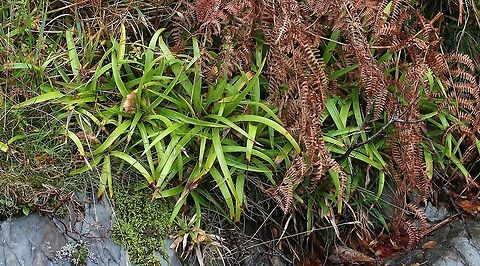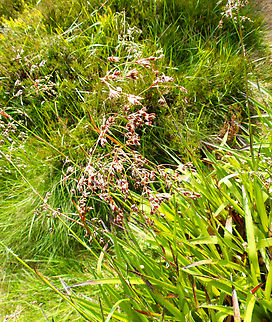
Appearance
"Luzula sylvatica" is the largest woodrush, with stems 30–80 centimetres high. It forms clumps of bright green leaves which are glossy, flat, linear, about 10–30 centimetres in length and 1 centimetre wide; its leaves remain green or at least greenish throughout winter.The leaves can also help to differentiate the plant from similar-looking plants in the closely related genus "Juncus", as scattered white hairs can be found along the leaf edges. Its tepals are 3–3.5 millimetres, with flowers which grow in groups of 3 or 4. From mid-spring to summer, "L. sylvatica " produces flowers in open panicles which are very small, chestnut-brown in colour and can be found in dense and lax clusters. "L. sylvatica" is sometimes stoloniferous.
"Luzula sylvatica" is both anemophilous and entomophilous, in that it can be pollinated by either wind or insect. "L. sylvaticas fruit is a 3-valved capsule containing three oblong seeds. Each seed is indistinctly reticulate, often with a caruncle; seeds tend to germinate close to their parent plant.

Naming
With regards to the etymology of the binomial, "Luzula" could come from the Italian "lucciola" or the Latin "luzulae" or "luxulae", from "lux", inspired by the way the plants sparkle when wet with dew; whilst "sylvatica" comes from silva, Latin for forest.Distribution
"Luzula sylvatica" has a wide distribution, and is native to Europe and southwest Asia - including the British Isles where "L. sylvatica" populations are widespread stable, apart from a decline in central and south east England. There is one record of "L. sylvatica" from Washington state, United States.Habitat
Usually growing in partial to full shade, "Luzula sylvatica" tends to grow on acidic soils in damp habitats. "L. sylvatica" can be found on stream banks and well-drained, open woodland, as well as in open ground and rock ledges and peaty heath moors. Despite its preference for acidic soils, it can tolerate most soil pH levels.Uses
"Luzula sylvatica" is commonly used in horticulture — its thick, patch-forming habit, hardiness, as well as the ability to grow in shade and damp soils being particular boons; "L. sylvatica" is commonly used for ground cover and/or as an ornamental grass.The cultivar ‘Marginata’ has gained the Royal Horticultural Society’s Award of Garden Merit.
References:
Some text fragments are auto parsed from Wikipedia.